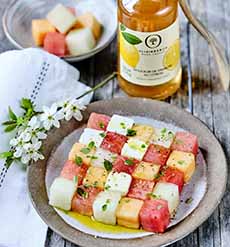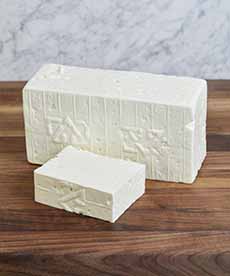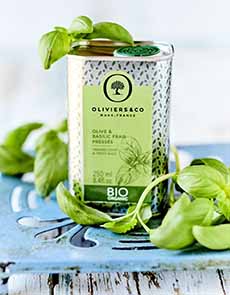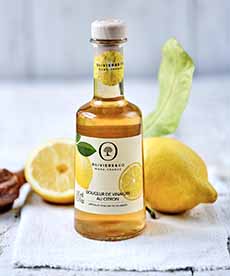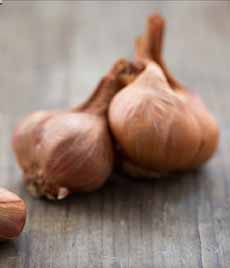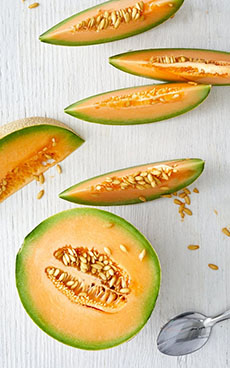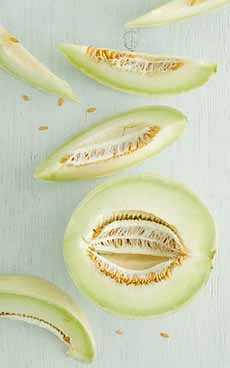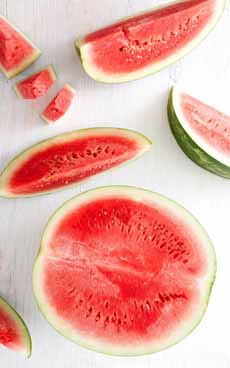A Checkerboard Melon Salad Recipe & The History Of Melon
|
|
If your knife skills are good—or if you want an occasion to practice them—consider this checkerboard salad made with cubes of melon, cucumber, and feta cheese. The recipe, created by Oliviers & Co, uses a dazzling vinaigrette made with the brand’s basil olive oil and lemon vinegar. After you’ve made it the original way, you can play with the dressing flavors. (We had chili oil and pomegranate vinegar, among other flavors, in our cupboard. We liked how the chili oil spiced things up. You could also shake a garnish of red chili flakes over the salad.) You can serve the checkerboard as an appetizer/first course/starter (see the differences below) or as dessert. The feta and fruit combination makes it a nouvelle cheese course. > The history of cantaloupe and honeydew melons is below. > The history of feta cheese. The original recipe called for cucumber instead of honeydew. We substituted honeydew because of the challenge of cutting cubes from a cucumber. If you choose to use a cucumber, get a seedless cucumber (also called an English cucumber or hot-house cucumber). 1. CUT the cantaloupe, honeydew, watermelon, and feta into as even cubes as possible and arrange them in a checkerboard pattern on 4 plates. 2. MIX the basil olive oil, lemon vinegar, and minced shallot. 3. DIVIDE and drizzle the dressing over the checkerboard, sprinkle with basil leaves, and serve chilled. While the three terms are sometimes used interchangeably depending on the restaurant, the difference between them centers on the size and complexity of the dish. All can be hot or cold. Cantaloupes are believed to have grown wild in areas from Turkey to China, including northwest India, Afghanistan, and Uzbekistan [source]. They were first cultivated in the Near East, in the Nile River Valley of Egypt. The Romans likely found them growing there and brought them back to Rome to cultivate. Cantaloupe, a subspecies of muskmelon (Cucumis melo subspecies. melo in the Cucurbitaceae family†) that was introduced to Europe in the 15th century. It quickly became popular for its sweetness. In fact, it’s the most popular type of muskmelon (Cucumis melo), the genus that also includes the casaba, charentais, crenshaw, galia, honeydew, Persian, spanspek, and Santa Claus melons, among others. The melon had been grown in the Mediterranean for millennia, but the name cantaloupe emerged in the 18th century via the French cantaloup. The story goes that back in the 15th century, the papacy had a summer country residence in Cantalupo di Sabina, a town in the Sabine Hills outside of Rome. Cantalupo means “howling wolf.” The melons were brought by an envoy from Armenia as a gift for Pope Paul II, who served from 1464 to 1471. They so delighted the pope that they were cultivated in the area. However, we’re not sure when Italians started calling the melon “cantalupo,” or whether the name came from one of the seven other towns in Italy and one town in France with the same name [source]. But, as we travel northward, the first known printed reference to “cantaloupe” appears in English in 1739 [source]. Christopher Columbus brought cantaloupe to the New World. Several cantaloupe varieties were reportedly grown in the West Indies as early as 1494. Cantaloupes were also cultivated by Native Americans near the present city of Montreal in 1535. While they may have been grown before the 18th century in the continental U.S., cantaloupes were cultivated in the vicinity of Philadelphia before 1748. It took until around 1890 for cantaloupe to become a commercial crop in the U.S., and it was initially and was initially centered in Delaware, Maryland, and New Jersey. Today the principal growing areas are California (accounting for more than 65% of the cantaloupe produced in the U.S.), Arizona (26%), with the remaining 9% divided mostly among Georgia and Florida [source]. The melons are available throughout the year but the harvesting season peaks in the summer. The history of honeydew melons somewhat parallels the history of cantaloupe. Honeydews (Cucumis melo var. inodorous) have been cultivated for thousands of years. Paintings of the melons were discovered in Egyptian tombs dating back to 2400 B.C.E. Egyptians regarded honeydew as a sacred fruit. Tomb hieroglyphics illustrate the melon’s possible uses in the afterlife. The melon’s exact origins are unknown. Some sources point to the Middle East, Western Asia, or West Africa as the first to cultivate the fruit, more than 4,000 years ago [source]. Honeydews were introduced to Europe in the 15th century, primarily to France and Algeria. They were cultivated in greenhouses. The melons were brought to the New World by Spanish and Portuguese explorers. Christopher Columbus brought seeds across the ocean, although indigenous peoples were already cultivating the fruit (or something similar) in temperate regions throughout North America. Spanish explorers began growing the melons in California, Honeydew melons acquired their name from an American plant breeder, John E. Gauger. The melons were initially known in France as melon d’Antibes blanc d’hiver or white Antibes winter melon. |
|
|
But as the melons were introduced to the U.S., many varieties were often unlabeled or given more commercial names. In 1911, the melon was served to guests at the restaurant of a high-end hotel in New York City. One guest enjoyed the unlabeled melon so much that he saved seeds from the fruit and mailed them to Gauger for further research (Gauger was famous for melon breeding). Gauger worked with the United States Department of Agriculture to identify the variety, and in 1915, the USDA concluded that the unknown seeds were from a white Antibes winter melon. Gauger renamed the melons as honeydew, a more appealing name for American consumers. Honeydew remains one of the primary names used for the variety worldwide. Honeydew melons thrive in semiarid, sunny climates and are grown worldwide. China and Turkey are the leading producers, followed by the U.S. in California and Arizona. The melons are also cultivated in Costa Rica, Guatemala, Honduras, and Mexico. Exported to the North American and European markets, they are available year-round [source]. *Hors d’oeuvres (pronounced: or DERV) is the master category of which a canapé is a subset. The term hors d’oeuvres translates to “outside of work,” referencing the fact that hors d’oeuvres are meant to be eaten as a separate event, rather than part of the main meal. (This is what distinguishes them from appetizers.) Hors d’oeuvre can be served hot or cold and can consist of small portions of just about anything savory. A canapé (can-uh-PAY) is a smaller hors d’oeuvre served on a base of bread, cracker, pastry, or toast. It is a finger food, eaten in one or two bites, and served cold (room temperature). Canapé is the French word for sofa. The idea is that the toppings sit atop a “sofa” of bread or pastry. † The Cucurbitaceae family also includes summer and winter squash, pumpkins, cucumbers, watermelons, and gourds. CHECK OUT WHAT’S HAPPENING ON OUR HOME PAGE, THENIBBLE.COM.
|
||
